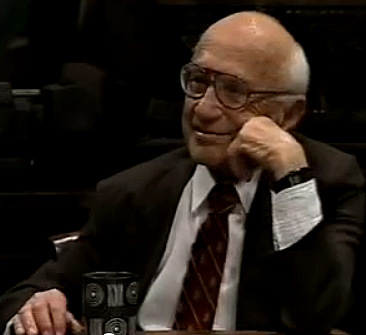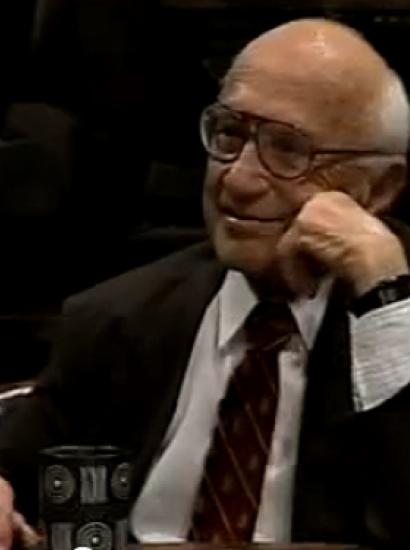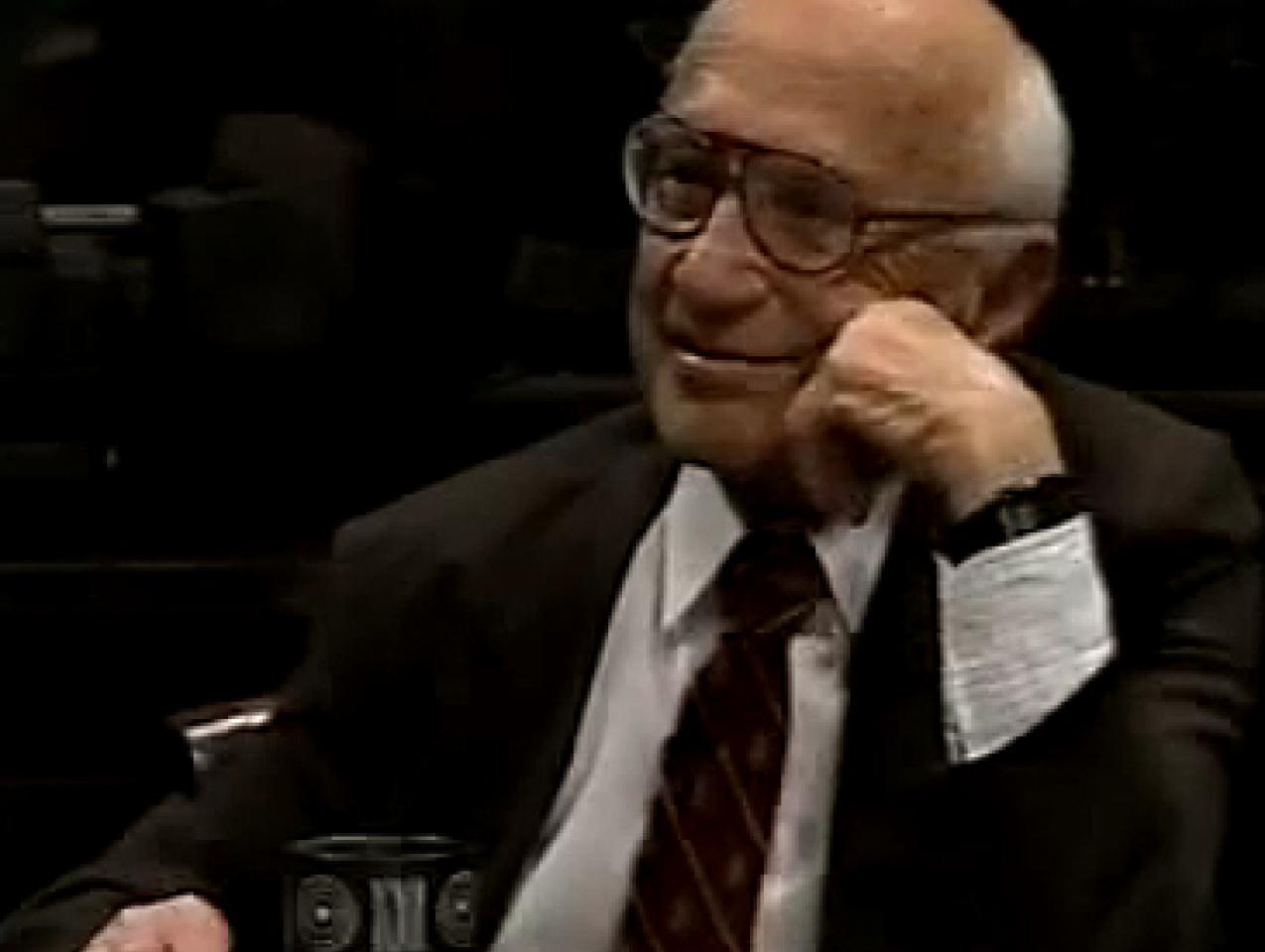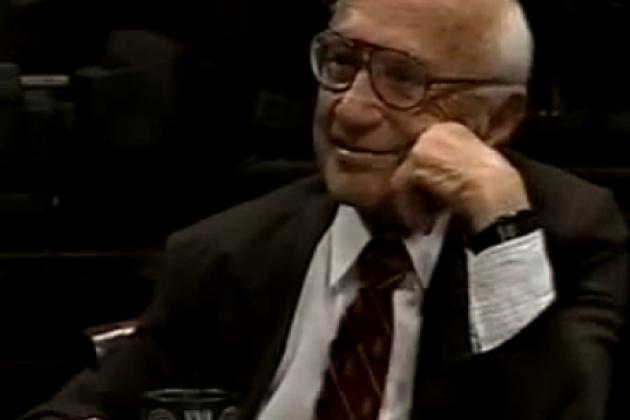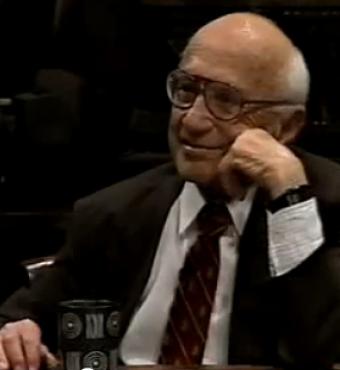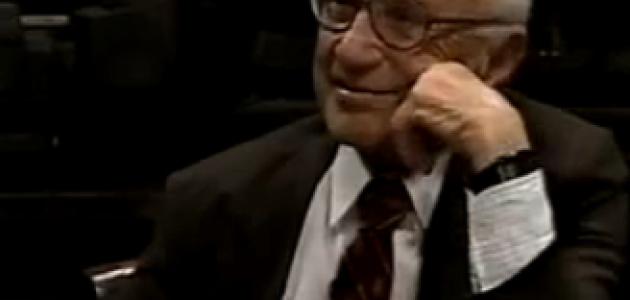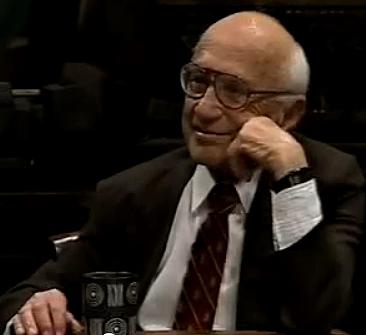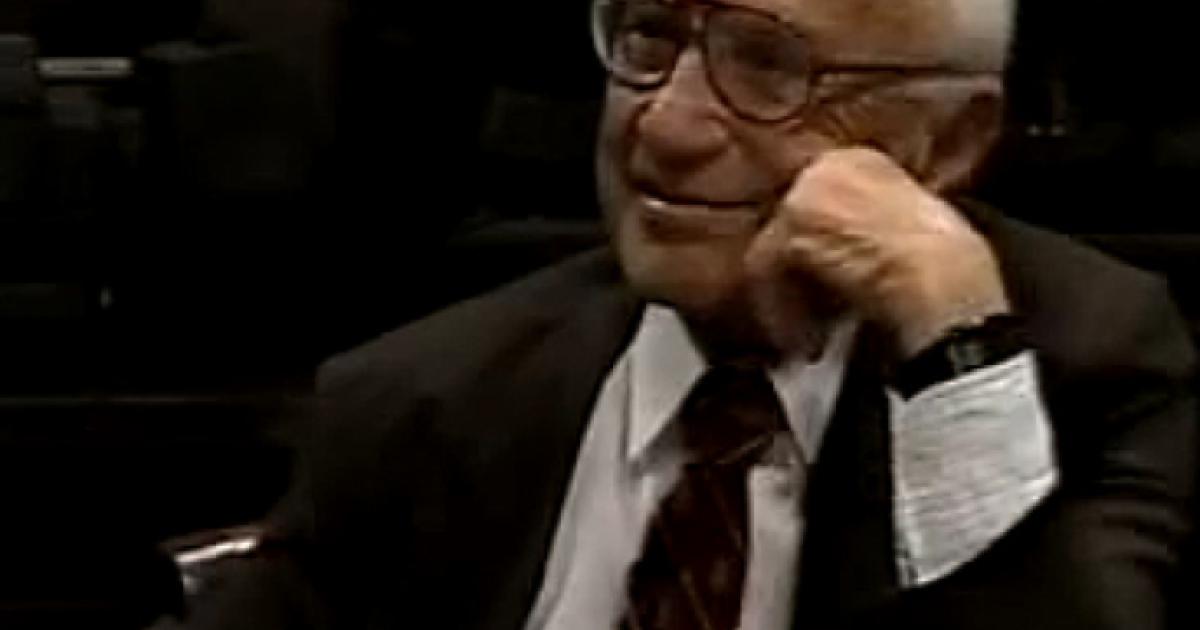There has been a lot of discussion in the past few years about how much impact Milton Friedman’s ideas and work have had on economic thinking and economic policy. Some critics of Friedman have exaggerated it. For example, in 2018, Larry Kramer of the Hewlett Foundation, in a scathing attack on Friedman, wrote:
Government regulation may persist in many arenas, but in the years since [Friedrich] Hayek’s and Friedman’s economic philosophy—now called “neoliberalism”—became ascendant, it has reshaped everything. Fiscal policy, monetary policy, labor policy, trade policy, welfare policy, and industrial policy, to name only a few, have been fundamentally altered in line with the ideas of Hayek and Friedman and their followers.
Kramer went on to say why he thought this influence was negative.
Other critics have claimed the opposite: that Friedman’s long-run impact is virtually zero. In “The End of Friedmanomics,” a particularly nasty recent article in the New Republic, Zachary D. Carter, a writer in residence with the Omidyar Network and the above-mentioned Hewlett Foundation, quotes Columbia University economist Jeffrey Sachs as follows: “Almost nothing remains of his intellectual legacy. It has proven to be a disastrous misdirection for the world’s economies.” Unfortunately, Carter doesn’t elaborate on Sachs’s point. But clearly we have two extremes here. The Hewlett Foundation, it appears, is open to a range of viewpoints on Milton Friedman as long as they’re negative.
The truth is somewhere between the two extremes. While Milton Friedman has not had as much effect on economic thinking and policy as many of us free market advocates would like, he has nevertheless had a huge impact.
On economic thinking, the following of Friedman’s ideas have held up well: that monetary policy is potent; that a contraction in the money supply between 1929 and 1933 helped put the “Great” in “the Great Depression”; that inflation “is always and everywhere a monetary phenomenon”; and that there is no long-run tradeoff between inflation and unemployment. On economic policy, his attribution of inflation to monetary policy rather than to unions or corporate monopolies has strengthened the hand of the Federal Reserve in fighting inflation. In the early 1970s, he opposed President Nixon’s economy-wide price controls as a way to end inflation. Although he was arguably in the minority in the economics profession at the time, most economists today would oppose such controls and their opposition has so far helped dissuade the federal government from imposing them. His activism in the late 1960s and early 1970s to end military conscription bore fruit: the draft was ended on January 27, 1973.
Friedman’s Effect on Monetary Policy
One of Friedman’s first big victories was on the importance of monetary policy. In a 1969 Newsweek column, when the majority of economists held the Keynesian view that monetary policy was impotent and fiscal policy was potent, MIT economist Paul Samuelson wrote:
[T]here is no sight in the world more awful than that of an old-time economist, foam-flecked at the mouth and hell-bent to cure inflation by monetary discipline. God willing, we shan’t soon see his like again.
God wasn’t willing. By the mid-to-late 1970s, Friedman’s view about the importance of monetary policy in affecting the inflation rate had become dominant. In fact, even Samuelson came to believe that monetary policy was potent. He never admitted that his view had changed or that Milton Friedman’s work had had any influence on him, but in his famous textbook, Economics, you can track his change in viewpoint edition by edition. Indeed, in my Wall Street Journal obituary of Samuelson, I did track it. By the 1985 edition, Samuelson and co-author William D. Nordhaus wrote that money “is the most powerful tool and useful tool that macroeconomic policy makers have.”
This change in economists’ views has been long-term. It’s fair to say that the majority of economists today believe that monetary policy is the main contributor to inflation.
Perhaps Friedman’s earliest break with the mainstream economics profession was his book, co-authored with Anna J. Schwartz, A Monetary History of the United States, 1867–1960. In this work, which took years of careful digging, Friedman and Schwartz meticulously measured and reported changes in various measures of the money supply. Their longest chapter is on the Great Depression. In that chapter, they showed that between 1929 and 1933, the money supply had fallen by 30 percent and that that fall had contributed mightily to the Great Depression. While a majority of economists today may not accept their view that the drop in the money supply was the most important cause of the Great Depression, economists who study that era certainly give the money supply factor a lot of weight.
In his speech as outgoing president of the American Economic Association, given in December 1967, Friedman argued, contrary to the Keynesian consensus, that there is no long-run tradeoff between inflation and unemployment. The reason for the short-run tradeoff, he argued, is that when there is unexpected inflation, unemployed workers are temporarily fooled into accepting a wage that is high in dollar terms but is not high when adjusted for inflation. When many workers do this, the unemployment rate falls temporarily. But when workers learn that their higher wage in dollar terms buys fewer goods and services than they had thought, some quit or, if laid off, take longer to find a job because they now understand that their higher dollar wage does not buy more goods. So the unemployment rate creeps back up. The only way to keep the unemployment rate down with inflation, argued Friedman, was for the Federal Reserve to keep increasing inflation by increasing the rate of growth of the money supply. In that way lay out-of-control inflation. That’s one reason Friedman advocated not an activist monetary policy but a stable one.
Friedman’s preferred monetary policy was for the Federal Reserve to increase the money supply by 3 to 5 percent annually. One of the major regulations that Friedman had for years advocated ending was Regulation Q, which made it illegal for banks to pay interest on checking accounts. When this regulation was repealed in 1986, checking accounts became a closer substitute for savings accounts. That meant that money moved more easily between the two and that meant, in turn, that it became harder for the Fed to target a particular measure of the money supply. Ironically, therefore, Friedman’s victory on Regulation Q led to problems with the monetary policy he advocated. Nevertheless, the Federal Reserve and other central banks seem to understand the importance of stable growth in the money supply.
Friedman’s Effect on Non-Monetary Economic Policy
In his 1962 book Capitalism and Freedom, written with the assistance of his wife, Rose D. Friedman, Friedman has a chapter titled “The Role of Government in a Free Society.” At the chapter’s end, he lists fourteen activities that the government was involved in at the time and says that all should be abolished. The activities include government price supports in agriculture, minimum wage laws, rent controls, Social Security, and government licensing requirements for people to engage in various occupations. Notice that none of these five has been abolished. Indeed, Presidents Johnson, Nixon, and Carter, who were in power after 1962, increased Social Security payments by much more than the inflation rate. So much for Larry Kramer’s claim that Friedman has had a huge influence on overall economic policy. More’s the pity, as the British say.
That’s the bad news. But the good news is that on four of the fourteen, there has been a major shift to economic freedom. Friedman called for ending the Texas government’s control of the Texas oil industry’s output; that’s gone. Friedman called for ending government setting of maximum interest rates on checking and savings accounts; that’s gone. He wanted to end “regulation of transportation by the Interstate Commerce Commission.” President Carter ended it and the ICC itself was abolished in 1995. As a bonus, Carter ended the Civil Aeronautics Board’s restrictions on airline travel and, ultimately, the CAB itself. Was Milton Friedman a major player on these three issues? Only on the setting of maximum interest rates on checking and savings accounts. He had long advocated repealing Measure Q and he was one of the few people doing so. Nevertheless, on these issues, he got his way.
What’s the fourth policy issue in 1962 on which Friedman succeeded? Friedman called for ending conscription in peacetime. It ended in January 1973. Moreover, in the 1960s Friedman became more radical; in a Newsweek column in December 1966, at the height of the Vietnam War, he advocated ending conscription immediately. And the draft ended two years before the war ended. Friedman deserves a lot of credit for this. He once wrote that conscription was the only issue on which he had lobbied congressmen. He was also a very effective member of President Nixon’s Commission on an All-Volunteer Armed Force, which was formed in March 1969, less than three months after Nixon took office, and which delivered its report in early 1970. As Friedman wrote in Two Lucky People, the commission had fifteen members, five of whom started out against the draft, five of whom favored the draft, and five of whom were on the fence. When the commission delivered its report, fourteen of the fifteen favored abolishing the draft. Given Friedman’s notable ability to persuade, there’s a high probability that Friedman influenced at least some of those nine commissioners who switched to being anti-draft. The fifteenth, Roy Wilkins, executive director of the NAACP, explained in a letter to Nixon that he had been ill and had missed five meetings. Notably, though, Wilkins wrote, “I would like to endorse the basic idea of moving towards an all-volunteer armed force, and to express my hope that you will be able to take steps in the near future to reduce reliance on conscription.”
Whether you think Milton Friedman’s effect on economic thinking and economic policy was good or bad—I’m in the former camp—the fact is that he had much less effect than some of his harshest critics have claimed and much more effect than other of his harshest critics have claimed. He left a major mark on economists’ thinking about monetary policy, the Federal Reserve’s contribution to the Great Depression, the large role of money supply increases in causing inflation, and the long-run tradeoff between inflation and unemployment.
Arguably, his most important policy victory, and one to which he was a major contributor, was ending military conscription. We have now had almost half a century without the draft. For that, many millions of young, middle-aged, and even old Americans, some of whom might be his critics, owe him gratitude.







